 |
| Category: Battles/WW2 |

|
|
|
|
|
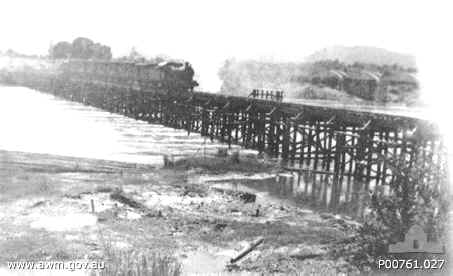 |
Tamarkan, Thailand. c.
1945.
Train crossing the wooden bridge which
spanned the Mae Klong River (renamed Kwai Yai River in 1960).
Begun in October 1942, using prisoner
of war (POW) labour, it was completed and operational by early February
1943. |
| Both the
wooden and the adjacent steel bridge were subjected to numerous air
raids between January and June 1945. POW labour was used to repair the
wooden bridge on each occasion. Tamarkan is fifty five kilometres north
of Nong Pladuk (also known as Non Pladuk), or five kilometres north of
Kanchanaburi. (Donor A. Mackinnon) |
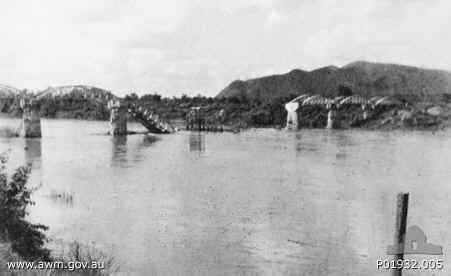 |
Tamarkan, Thailand. c. October 1945.
Located fifty five kilometres north of
Nong Pladuk (also known as Non Pladuk), 359 kilometres south of
Thanbyuzayat, and five kilometres north of Kanchanaburi (Kanburi). |
| The
photograph shows the two bridges built by the Japanese, using prisoner
of war (POW) labour, which spanned the Mae Klong river (renamed Kwa Yai
river in 1960).The wooden trestle bridge was completed in February 1943,
and the steel bridge in April 1943.
This eleven span bridge had been
dismantled by the Japanese and brought to Tamarkan from Java in 1942.
Both bridges wee subjected to numerous attacks by Allied aircraft during
the period December 1944 to June 1945. One span of the steel bridge was
destroyed in a raid mid February 1945. Two more spans were dropped
during raids between April and June 1945. (cont'd
below)
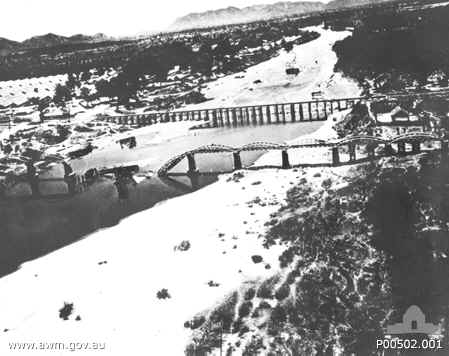 |
Aerial photograph of
the Bridge over the River Kwai, Thailand, severely damaged by
aerial bombing. |
|
The Bridge on the River
Kwai, the movie |
| The Bridge on the River Kwai
(1957), the memorable, epic World War II adventure/action,
anti-war drama, was the first of director David Lean's major
multi-million dollar, wide-screen super-spectaculars (his later
epics included Lawrence
of Arabia (1962) and Doctor Zhivago (1965)).
The screenplay was based upon French author
Pierre Boulle's 1954 novel of the same name. [Boulle was better
known for his screenplay for Planet of the Apes (1963).]
Although he received sole screenplay credit, other deliberately
uncredited, blacklisted co-scripting authors (exiled Carl Foreman
- who scripted High
Noon (1952) - and Michael Wilson) had collaborated with
him, but were denied elibigility. They were post-humously credited
years later, in late 1984, in a special Academy ceremony. [When
the film was restored, the names of Wilson and Foreman were added
to the credits.] |
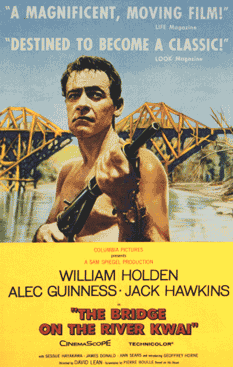 |
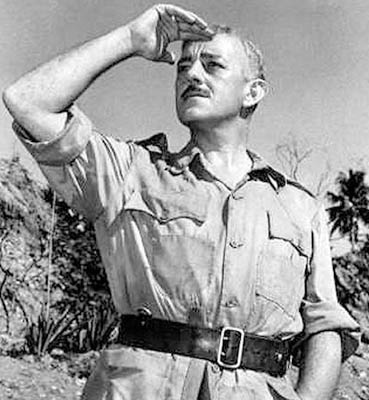
Col. Shears (Alec Guinness)
in The Bridge on the River Kwai. |
[The film's story was loosely
based on a true World War II incident, and the real-life
character of Lieutenant Colonel Philip Toosey. One of a
number of Allied POW's, Toosey was in charge of his men from
late 1942 through May 1943 when they were ordered to build
two Kwai River bridges in Burma (one of steel, one of wood),
to help move Japanese supplies and troops from Bangkok to
Rangoon.
In reality, the actual bridge took 8
months to build (rather than two months), and they were
actually used for two years, and were only destroyed two
years after their construction - in late June 1945. The
memoirs of the 'real' Colonel Nicholson were compiled into a
1991 book by Peter Davies entitled The Man Behind the
Bridge.] |
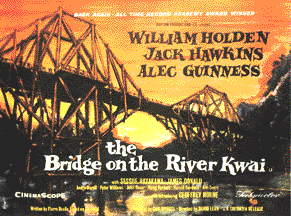 |
The film was
the number one box-office success of the year (the highest
grossing film) and it won critical acclaim as well - eight
Academy Award nominations and seven Academy Awards: Best
Picture, Best Actor (Alec Guinness), Best Director, Best
Screenplay Based on Material from Another Medium (Pierre
Boulle), Best Cinematography, Best Score, and Best Film
Editing. |
Only Sessue Hayakawa, a former silent screen
star and one of the first important Asian stars, who was nominated
for his Best Supporting Actor role as the hot-tempered Japanese
colonel, lost. The film created an additional stir when it debuted
on ABC television on September 25, 1966. The date was dubbed
"Black Sunday" due to the loss of business at movie
theatres on account of its popular airing. |
Cont'd.
Tamarkan POW camp was located adjacent to both the bridges and a nearby
Japanese anti-aircraft battery. It also suffered during these air raids,
the worst being on 29 November 1944. During this attack on the Ack Ack
battery, three bombs overcarried and demolished the top ends of POW huts
1 and 2, burying a number of the occupants.
The POW casualties numbered nineteen
killed and sixty eight wounded. During a four hour attack on the bridges
and Ack Ack battery on 5 February 1945, a further fifteen POWs were
injured. The camp site was littered with great fragments of shrapnel,
and one hut and the canteen were burnt to the ground. On 14 February
1945, the Japanese evacuated the remaining POWs to the Chungkai camp
which was located approximately two kilometres north on Kanchanaburi, on
the bank of the River Kwai Noi.
Photographed by the War Graves
Commission survey party whose task was to located POW cemeteries and
grave sites along the Burma-Thailand railway. They also took the
opportunity to recover equipment and documents, which had been secretly
buried, under instructions from senior POW officers, in the graves of
deceased POWS. (Donor B. Evans) |
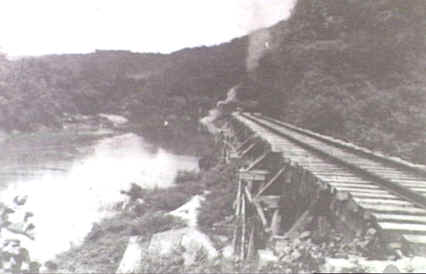 |
Wampo (Wang Po), Thailand.
c. September 1945.
The Wampo tiered viaduct built along
the edge of the Kwai Noi River.
The two main viaducts followed the
bottom of the cliff for some distance. A ledge had to be carved out of
the cliff face to form a base for the bridge and embankment
construction. |
| It
was a dangerous and exhausting task for the POW work force. Wampo is
approximately 114 kilometres north of Nong Pladuk (also known as Non
Pladuk), or 300 kilometres south of Thanbyuzayat. (Donor A. Mackinnon) |
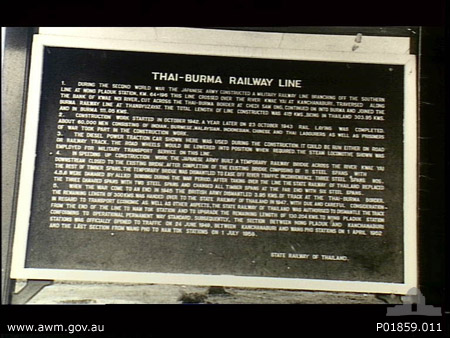 |
Kanchanaburi, Thailand,
1973.
A memorial plaque erected on the
southern bank of the River Kwai, at one end of the bridge which was
built over the river by allied prisoners-of-war (POWs) and Asian
labourers from various countries. |
| The
inscription on the plaque reads: "Thai-Burma Railway Line.
1. During the Second World War the
Japanese Army constructed a military railway line branching off the
southern line at Nong Pladuk (also known as Non Pladuk) Station,
Km.64+196.
This line crossed over the River Kwae
Yai at Kanchanaburi, traversed along the bank of Kwae Noi River, cut
across the Thai-Burma border at Chedi Sam Ong, continued on into Burma
and joined the Burma railway line at Thanbyuzayat. The total length of
line constructed was 419 kms., being in Thailand 303.95 kms. and in
Burma 111.05 kms.
2. Construction work started in
October 1942. A year later on 23 October 1943 rail laying was completed.
About 60,000 men consisting of Indian, Burmese, Malaysian, Indonesian,
Chinese and Thai labourers as well as prisoners of war took part in the
construction work.
3. The diesel power traction car shown
here was used during the construction. It could be run either on road or
railway track. The road wheels would be lowered into position when
required. The steam locomotive shown was employed for military transport
service on this line.
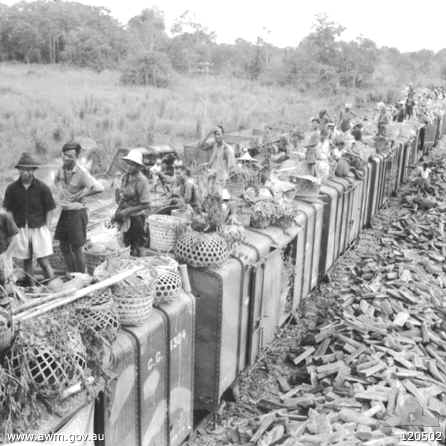 |
Wampo
(Wang Po), Thailand. 21 October 1945.
Wampo is approximately 114 kilometres north of
Nong Pladuk, or 300 kilometres south of Thanbyuzayat.
A diesel rail car passing over the long trestle
bridge commonly known as the Wampo viaduct.
This tiered viaduct was built along the edge of
the Kwai Noi river. The two main sections of the viaduct followed
the bottom of the cliff for some distance. |
| A
ledge had to be carved out of the cliff face to form a base for
the bridge and embankment construction. It was a dangerous and
exhausting task for the prisoner of war (POW) work force. Wampo is
approximately 114 kilometres north of Nong Pladuk (also known as
Non Pladuk), or 300 kilometres south of Thanbyuzayat. Strengthened
and rebuilt to the original design in the post-war years, the
viaduct forms part of the railway which is still operational as
far as Namtok (Tarsau). |
4. In speeding up construction work
the Japanese Army built a temporary railway bridge across the River Kwae
Yai downstream close to the existing bridge. After completion of the
existing bridge composing of 11 steel spans with the rest of timber
spans, the temporary bridge was dismantled to ease off river traffic
inconvenience. Three steel spans nos. 4, 5, 6 were damaged by allied
bombing during the war period. After taking over the line the State
Railway of Thailand replaced the three damaged spans with two steel
spans and changed all timber spans at the far end with six steel
spans.
5. When the war come [sic] to an end
in 1945 the British Army dismantled 3.95 kms. of track at the Thai-Burma
border. The remaining length of 300 kms. was handed over to the State
Railway of Thailand in 1947. With due and careful consideration in
regard to transport economic as well as other aspects, the State Railway
of Thailand was authorised to dismantle the track from the end of the
line to Nam Tok Station and to upgrade the remaining length of 130.204
kms. to Nong Pladuk Station conforming to operational permanent way
standard. Subsequently, the section between Nong Pladuk and Kanchanaburi
Stations was officially opened to traffic on 24 June 1949, between
Kanchanaburi and Wang Pho Stations on 1 April 1952 and the last section
from Wang Pho to Nam Tok Stations on 1 July 1958.
State Railway of Thailand. (Donor
C. Scriven) |
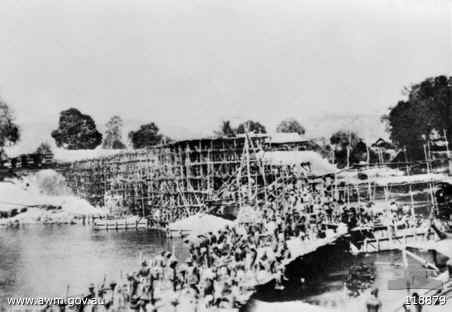 |
Burma-Thailand
Railway.
c. February 1943.
Allied prisoners of war (POWs) engaged
in bridge building at Tamarkan, fifty five kilometres north of Nong
Pladuk (also known as Non Pladuk) and five kilometres south of
Kanchanaburi (Kanburi).
|
| The
scaffolding, made from bamboo, is at the site of the eleven span steel
bridge which was completed in April 1943. It, together with a wooden
bridge approximately 100 kilometres downstream, spanned the Mae Klong
river (renamed Kwai Yai river in 1960). |
| Tamarkan, Thailand. c.
September 1945.
A view of Tamarkan prisoner of war
(POW) camp showing rows of huts with thatched attap roofs and open
walls.
Tamarkan camp was adjacent to the two
bridges which spanned the Mae Klong River (renamed Kwai Yai River in
1970). It is |
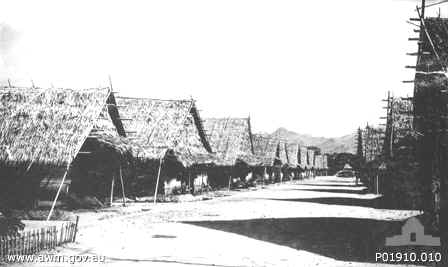 |
| fifty
five kilometres north of Nong Pladuk (also known as Non Pladuk) and five
kilometres north of Kanchanaburi. Photographed by the War Graves
Commission survey party whose task was to locate POW cemeteries and
grave sites along the Burma-Thailand railway. They also took the
opportunity to recover equipment and documents which had been secretly
buried, under instructions from senior POW officers, in the graves of
deceased POWs. (Donor L. Cody) |
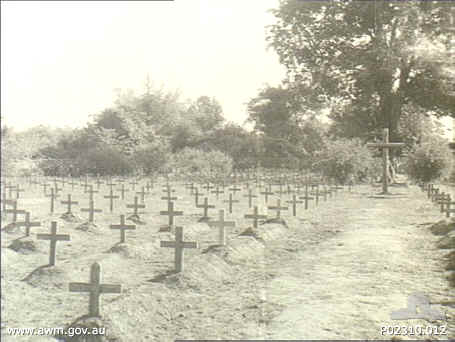 |
Chungkai (Kao Poon),
Thailand. September 1945.
Approximately two kilometres
north of Kanchanaburi (Kanburi) on the bank of the Kwai Noi river.
Temporary wooden crosses on the
graves of Allied soldiers (prisoners of war (POWs)) in the Chungkai
cemetery.
|
| There
were two cemeteries, one with 1,500 graves and one with 168 graves.
Those Australians who had been buried in these two cemeteries, were
exhumed and reburied in the Kanchanaburi War Cemetery towards the end of
1945. The Chungkai War Cemetery is located in exactly the same site as
used for POW burials between 1943 and 1945. (Donor B. Leemon) |
|